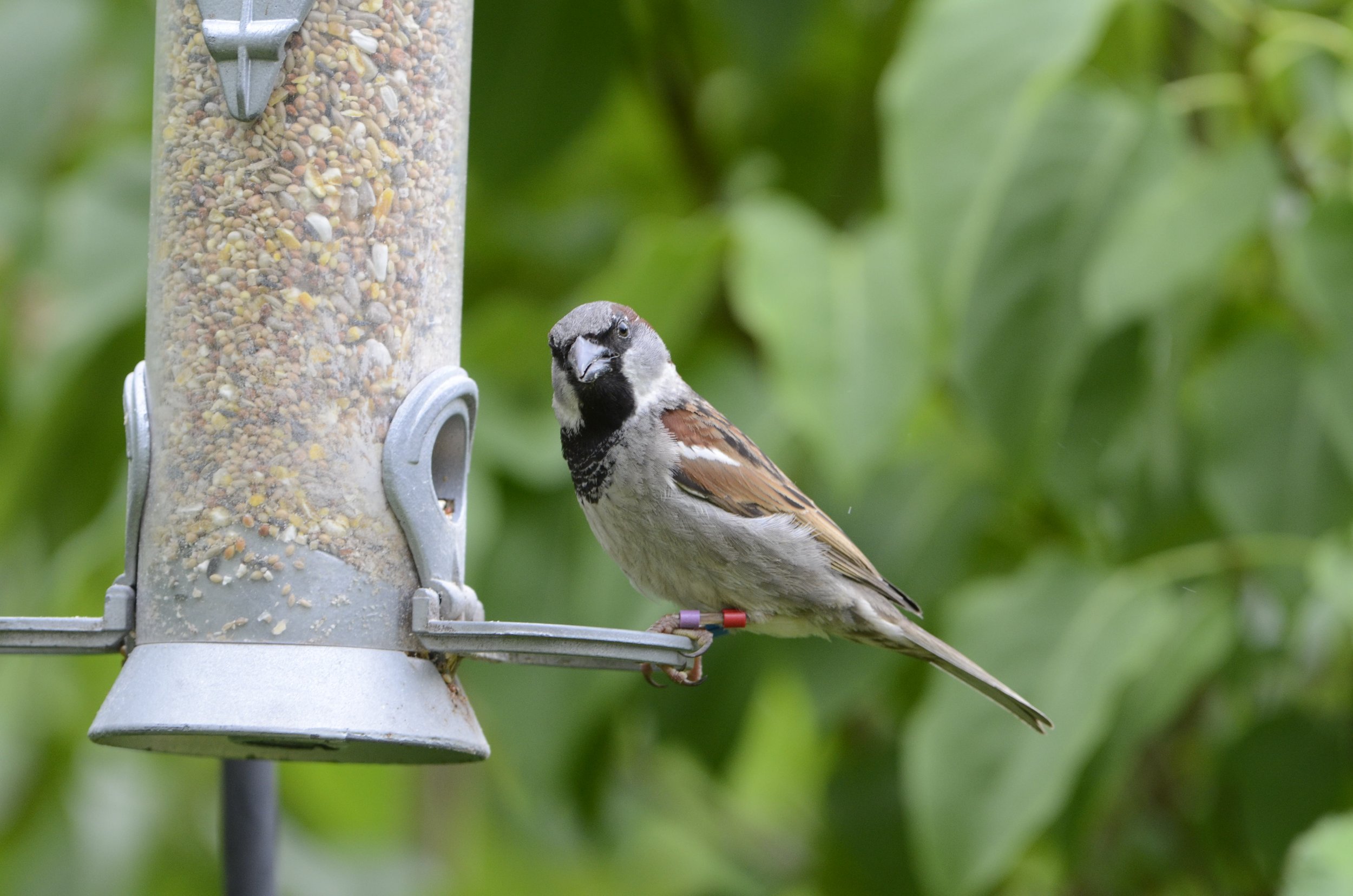From behavior to welfare: Ross MacLeod’s wild bird research
Feeding stations encourage wild birds to gather in relatively large numbers, making it easier for researchers to measure their body temperatures using thermal imaging cameras. Photo courtesy of Ross MacLeod.
March 28, 2025
“A lot of scientists like me were always interested in welfare, but unless it was captive animals, pets, or agriculture, you really couldn’t work on it. And I think that’s changed — I really think Wild Animal Initiative has encouraged a whole rethink of what’s possible.”
Ross MacLeod is Senior Lecturer in Behavioural Ecology at Liverpool John Moores University (LJMU) in the United Kingdom. Supported by a Wild Animal Initiative Seed Grant, Ross and his research team are using thermal imaging cameras to measure the surface body temperatures of wild birds. The data they collect will point to whether the birds’ surface body temperatures are linked to starvation risk, predation risk, or human disturbance — environmental stressors that could contribute to poor welfare.
Throughout Ross’s career, much of his research has explored how wild animals’ individual behavioral and physiological responses can be used to predict population- and ecosystem-level responses to environmental stressors. Despite Ross’s interest in welfare, his work prior to receiving funding from WAI was confined to behavioral ecology, conservation, and population ecology. “That’s what you could get funding to do and what you could publish papers on,” he says.
But applying his research skills to wild animal welfare has been intuitive for Ross. Behavioral ecologists, he explains, are used to seeing animals as individuals. “Welfare was in everything I did, but I never wrote about it in those terms. Now, Wild Animal Initiative has created this space that didn’t exist before. I’m taking a lot of the techniques and approaches I’ve always used, but I’m able to actually answer wild animal welfare questions, which is what really excites me.”
Focusing on welfare is allowing Ross’s team to develop new ways of monitoring animals, and the funding from WAI has given Ross the time and resources to validate methods for studying it.
The ultimate goal of Ross’s thermal imaging project is to develop a standardized thermal imaging method that could monitor the surface temperature of not only wild birds, but other taxa too, including common species like rodents that are neglected in conservation research. The new method could enable researchers to track and monitor chronic physiological stress in populations of animals facing a range of environmental stressors.
“What I really care about is what difference we can make.”
— Ross MacLeod
Photo courtesy of Ross MacLeod.
To test and validate the imaging method, the LJMU collaborative research team — which includes WAI grantees Julia Nowack and Luiza Figueiredo Passos, plus PhD student Sally Westworth — monitored wild bird communities at 54 standardized feeding stations across three urban-rural gradients in the UK.
With fieldwork now complete, Ross and the team are preparing to publish the results of the thermal imaging project. But their work on wild bird welfare is ongoing.
They’ve now begun a bigger and more complex project, funded by a Wild Animal Initiative Challenge Grant, and focusing on house sparrows.
House sparrows are excellent subjects for wild animal welfare research because they’re the most abundant birds in the wild. Identifying interventions that could benefit their welfare could be particularly cost-effective for this reason. But knowledge about their welfare and how to improve it might translate to other bird species, too.
Ross’s Challenge Grant project will adapt a modeling framework that he has already used successfully in an ecological context, to predict changes in population size based on habitat composition. By incorporating thermal imaging measurements into the framework, Ross and his team will use it to explain and predict changes in welfare status for local populations of house sparrows.
The project has great potential to assist future research on modeling total welfare in a population. Once the framework is validated for use in welfare research, researchers can use it to predict welfare from observation and understanding of habitat selection patterns. This could produce the data needed to explore the welfare impacts of density dependence and resource access on millions of wild birds and other taxa for which habitat selection can be monitored.
Better backyards for birds
But it’s the potential application of his research that motivates Ross. How could the information be used to improve the lives of wild animals? “Thanks to the grants,” he says, “we’ll spend a lot of time that we otherwise wouldn’t have thinking about welfare. But the funding has also changed my thoughts on what’s possible in terms of interventions.”
Ross is particularly interested in managing habitat for welfare. “That might be things like putting in extra hedges, or dividing a garden into two parts so that birds and other animals don’t have to go as far to get cover from predators,” he says. He thinks it's possible that an intervention like this could improve welfare for many animals if it’s implemented on a large scale.
Because habitat management is an established practice, it might be relatively straightforward to make adjustments to manage habitat for welfare, too — which is why Ross thinks it’s such a promising set of interventions to explore. Another reason is that, compared to some other welfare interventions that require ongoing maintenance — like administering contraception or vaccines — managing for habitat can be a one-and-done intervention. Once an extra hedge is planted, for example, it’s likely to remain there indefinitely.
Ross MacLeod explains the features of a research station at LJMU’s Wildlife Teaching and Research Facility.
Ross expects that within two years, he’ll be able to provide bird conservation nonprofits with evidence-based recommendations for how people can optimize their backyards to improve house sparrow welfare.
We don’t yet know how managing habitat for house sparrow welfare might impact other wild animals, though — there’s a possibility that interventions that help house sparrows might harm other birds. Future research building on Ross’s will need to explore the network effects of house sparrow welfare interventions to understand their wider impact. Do they incur tradeoffs with other species? Do they improve net welfare within an ecosystem, or lessen it?
Ross is hopeful that, as these answers emerge, not only wildlife managers, but anyone with a garden will have the chance to improve life for backyard birds. “I’m a scientist and I’m interested in scientific questions,” he says, “but what I really care about is what difference we can make. If we figure out what’s better for birds and tell people how to do that in their gardens, we could very quickly improve the lives of hundreds of thousands of animals. To me, that’s extremely exciting.”



